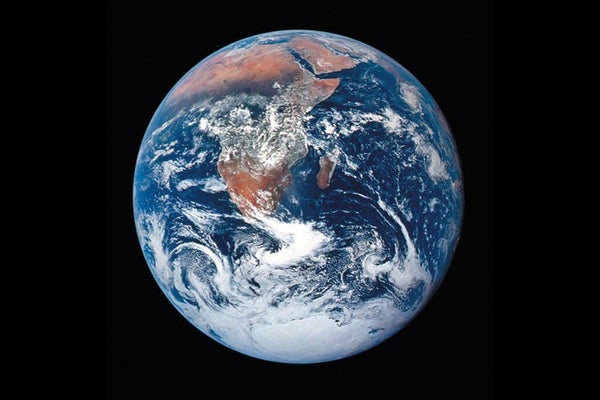Viewers of a certain age (including my own) may remember the children's TV show Big Blue Marble—reminiscent of the photograph of our water world taken by Apollo 17 astronauts in 1972 (top). I found myself reflecting on that image of a blue oasis in an inky cosmos as we put together this issue. Although we at Scientific American didn't set out to plan a special report on life and our ocean planet, you'll see a liquid line running through this edition's feature “well” (as we editors call the section of main articles).
For starters, here's a headline: “Meltdown,” by Jennifer A. Francis, who studies marine and coastal sciences. Francis describes how the Arctic climate is shattering record after record—at least a dozen in the past three years—altering weather worldwide. Sea ice is vanishing, air temperatures are rising, permafrost is thawing and glaciers are shrinking.
Meanwhile our traditional view of the ocean food web most likely is all wrong, writes Aditee Mitra, a zooplankton researcher, in her feature, “The Perfect Beast.” Meet mixotrophs: tiny ocean creatures that grow like plants but hunt like animal predators. They sound unusual, but they are not. The majority of the seas' single-celled plankton are neither pure plants nor pure eaters of plants. And they collectively have an outsize ecosystem impact: their activities may control everything from the health of fish to the amount of carbon that leads to global warming.
On supporting science journalism
If you're enjoying this article, consider supporting our award-winning journalism by subscribing. By purchasing a subscription you are helping to ensure the future of impactful stories about the discoveries and ideas shaping our world today.
At the risk of being chided by our stalwart copyediting team, may I call the gorgeous images in “How Seashells Take Shape” (wait for it) splashy? Researchers Derek E. Moulton, Alain Goriely and Régis Chirat apply mathematical modeling to help understand the forces that govern the elegantly complex forms of mollusk spines, spirals and ribs. Using differential geometry, they have identified a few simple rules that mollusks employ to build fantastic shapes. Read the article to see the wonders within and without.
Stepping out of the seas, science and society intertwine in other articles in the issue: research advances bring new hope for saving lives in an important yet often overlooked area (“Preventing Suicide,”); mechanical pulses may be driving communication among nerve cells (“The Brain, Reimagined”); a powerful new approach to therapy could come from the recognition that genetic changes enabling tumor cells to develop arise surprisingly early (“The Cancer Tree”); and strange bursts of radio light in the distant cosmos offer enticing puzzles for curious minds (“Flashes in the Night”). An ocean of discovery awaits.
